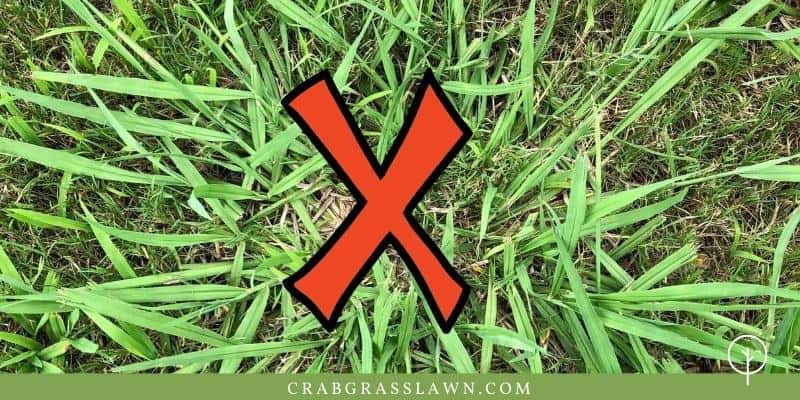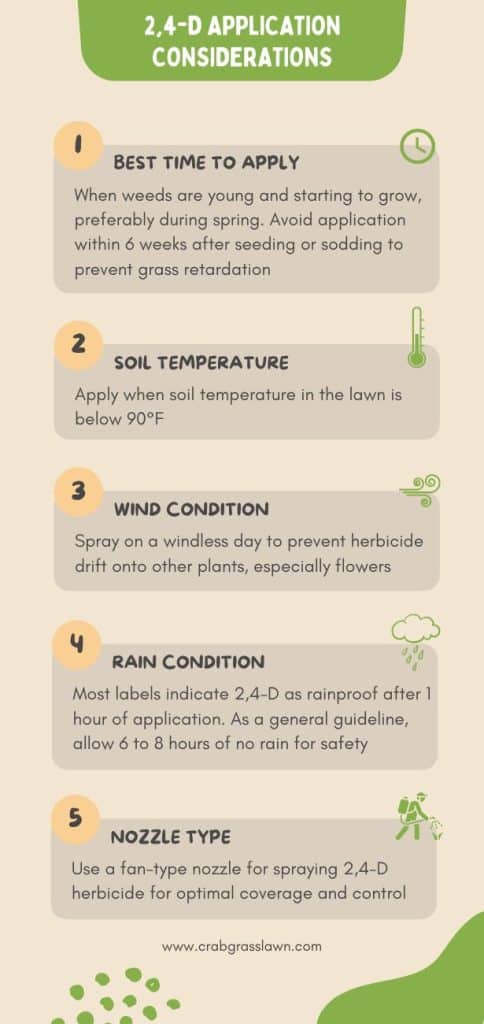2,4-Dichlorophenoxyacetic acid (2, 4-D) is a systemic herbicide that selectively kills broadleaf weeds. It is classified as an auxin-type herbicide because it causes cells in plant tissues that transport water and nutrients to grow endlessly. In other words, it destroys weeds by altering the way the cells of these plants grow.
Quick Answer
If your goal is to eliminate broadleaf weeds, you may be considering using 2,4-D. It’s safe to apply 2,4-D on your lawn, but it’s important to get the mixing ratio, timing, and application rate right.
Is 2, 4-D safe for lawns?
2,4-D is safe for lawns since herbicides containing it as the active ingredient do control most broadleaf weeds without harming the grass. You can spray it on your lawn in the right ratio to eliminate various non-grassy weeds, aka broadleaf weeds.
Caution should be taken, however, before spraying 2,4-D weed killers on turfgrass. Read the label to ensure that it is good for use on your particular turfgrass variety. Here’s the 2,4-D general factsheet for your reference.
Pro tip: I noticed Hi-Yield 2, 4-D is not labeled for use on St. Augustine grass. The product label cautions that the herbicide can cause injury to St. Augustine grass. If you plan to control broadleaf weeds using a selective herbicide on this type of grass, Trimec Southern Broadleaf Herbicide is a better option.
However, Trimec is also not labeled for use on Floratam, a variety of St. Augustine grass.
Most of the 2, 4-D weed killers are safe for use on Bermuda grass – a common Southern lawn grass. Be careful not to apply this herbicide to kill broadleaf weeds in dormant Bermuda grass or even during spring green up, and hot summer temperatures, as this grass is sensitive to this herbicide. It can destroy your lawn in its dormancy stage, usually around the month of January.
Best 2, 4-D Weed Killers
Affiliate links and images pulled from the Amazon Product Advertising API on: 2024-04-26
What weeds does 2, 4-D kill?
Not all lawn weeds can be killed using a 2, 4-D formula. Most products with 2,4-dichlorophenoxyacetic acid as the active ingredient are indicated to be used in non-crop areas to control weeds.
You can apply this broadleaf weed killer on lawns and on ornamental turf, driveways, patio areas, drainage ditch banks, and fence rows.
Here’s a list of weeds that 2, 4-D kills:
| Alder | Canada thistle |
| Galinsoga | Marijuana |
| Purslane | Toadflax |
| Alligator weed | Carolina geranium |
| Goatsbeard | Marshelder |
| Ragweed | Tumbleweed |
| American lotus | Carpetweed |
| Goldenrod | Mexican weed |
| Red clover | Velvet leaf |
| Arrowhead | Catnip |
| Goosefoot | Morningglory |
| Rush | Vervain |
| Artichoke | Chickweed |
| Ground ivy | Mousetail |
| Russian thistle | Vetch |
| Aster | Chicory |
| Gumweed | Muskthistle |
| Sagebrush | Virginia copperleaf |
| Austrian fieldcress | Cinquefoil |
| Healall | Mustard |
| St. Johnswort | Virginia creeper |
| Beggartick | Cockle |
| Hemp | Nettle |
| Salsify | Water hyacinth |
| Biden | Cocklebur |
| Henbit | Nutgrass |
| Shepherdspurse | Water lily |
| Bindweed | Coffee bean |
| Hoary cress | Orange hawkweed |
| Sicklepod | Water plantain |
| Bittercress | Coffeeweed |
| Honeysuckle | Parrot feather |
| Smartweed | Water primrose |
| Bitterweed | Common sowthistle |
| Horsetail | Parsnip |
| Sneezeweed | Water shield |
| Bitter wintercress | Creeping |
| Indigo | Jenny |
| Southern wild rose | Pennycress |
| Blackeyed | Wild carrot |
| Susan | Croton |
| Indiana mallow | Pennywort |
| Sowthistle | Wild garlic |
| Blessed thistle | Curly indigo |
| Ironweed | Pepperweed |
| Spanishneedle | Wild lettuce |
| Blue lettuce | Dandelion |
| Jerusalem artichoke | Pigweed |
| Spatterdock | Wild onion |
| Box elder | Devil’s claw |
| Jewelweed | Plantain |
| Speedwell | Wild parsnip |
| Broomweed | Dock |
| Jimsonweed | Poison hemlock |
| Stinging nettle | Wild radish |
| Buckhorn | Dogbane |
| Kochia | Poison ivy |
| Stinkweed | Wild rape |
| Bullnettle | Duckweed |
| Knotweed | Pokeweed |
| Sumac | Wild strawberry |
| Bull thistle | Elderberry |
| Lambsquarter | Poorjoe |
| Sunflower | Wild sweet potato |
| Bulrush | Flea bane (daisy) |
| Locoweed | Povertyweed |
| Sweet clover | Willow |
| Burdock | Flixweed |
| Lupine | Prickly lettuce |
| Tanweed | Witchweed |
| Bur ragweed | Florida pusley |
| Mallow | Primrose |
| Tarweed | Wormseed |
| Buttercup | Frenchweed |
| Many flowered aster | Puncture vine |
| Thistle | Yellow rocket |
As you can see, the only grass that 2,4-D can kill is nutgrass. The rest is just a list of broadleaf weeds.
Does 2, 4-D Kill Crabgrass?

Crabgrass is a tough grass weed that keeps coming back if not controlled with a strong crabgrass pre-emergent and killer. 2,4-dichlorophenoxyacetic acid is indicated to kill broadleaf weeds, but not most grass weeds.
Therefore, 2,4-D will NOT KILL CRABGRASS. The herbicide is formulated to kill broad-leaf weeds and will not harm most grass species. Crabgrass is a species of grass and will not be affected when you spray 2,4-D to control weeds in your lawn.
If you have a crabgrass or a nutsedge problem in your lawn, you might want to try a strong grass weed killer for lawns to help you get rid of those grassy weeds. Most of the best weed killers that control crabgrass are non-selective, meaning they will harm any plant they come in contact with.
Therefore, for crabgrass control, ensure you use the spot-spray technique and follow it with overseeding to prevent having bare spots on your lawn.
A great crabgrass killer I recommend for killing crabgrass is the Drive XLR8 Herbicide. I’ve seen great results when trying to eliminate this grassy weed just by spot-treating the areas of infestation.
2, 4-D Mixing Ratio and Application Rate
Each brand of 2, 4-D herbicide comes with its own mixing ratio on the instruction label. The ratio and application rate depend on the concentration of the active ingredient in the herbicide.
In general, mix 2.5 oz of 2, 4-D weed killer (5 tablespoonfuls) with 1 gallon of water and use it to treat 400 square feet of weed-infested area in your yard. You can double the dose to 5oz per 2 gallons of water for treating 800 to 1000 square feet of weed-laden grass.
Note that this is not the exact mixing ratio for all 2, 4-D liquid herbicide brands. Always read the label for the recommended ratios and rate.
For example, Hi-Yield 2, 4-D mixing ratio for small areas:
- Use 3 to 4 fluid ounces (6 to 8 Tablespoons) per 1,000 square feet.
- Mix 1 – 3 gallons of water and apply uniformly over the area when weeds are small and growing actively before bud stage.
- The best time to apply is usually during spring and fall when the weeds are actively growing.
When to spray 2 4 d on the lawn
The best time to apply 2, 4-D weed killer on your lawn is when weeds are still young and starting to grow or growing actively.
This may be during spring, although some weeds germinate in fall and summer. Spray 2,4-D at least 6 weeks after newly seeding or sodding your lawn to prevent stunting the grass.
The timing for the specific day is also important. Ensure you apply this herbicide when the soil temperature in your lawn is below 90 F.
Take note that 2,4-D can also harm other plants such as flowers, so time the application on a non-windy day. This is to prevent the herbicide from spreading onto other plants and harming them.
But should you apply 2, 4-D before or after rain?
Most labels indicate that 2, 4-D is rainproof one hour after application. However, since most brands do not indicate on the label, it is safe to go with 6 to 8 hours of no rain. The ester in most of the herbicide formulations is rainproof within 1 hour. There are a few key differences between amines and ester herbicides.
It is important to use a fan-type nozzle when spraying 2,4-D.

| 2,4-D Application Considerations | Recommendation |
|---|---|
| Best Time to Apply | When weeds are young and starting to grow, preferably during spring. Avoid application within 6 weeks after seeding or sodding to prevent grass retardation |
| Soil Temperature | Apply when soil temperature in the lawn is below 90°F |
| Wind Condition | Spray on a windless day to prevent herbicide drift onto other plants, especially flowers |
| Rain Condition | Most labels indicate 2,4-D as rainproof after 1 hour of application. As a general guideline, allow 6 to 8 hours of no rain for safety |
| Nozzle Type | Use a fan-type nozzle for spraying 2,4-D herbicide for optimal coverage and control |
FAQs on 2,4-D
2, 4-D vs Glyphosate
Glyphosate is formulated to control a wide range of weeds including grassy weeds, whereas 2,4-D is only effective against broadleaf weeds.
You can tank-mix 2,4-D and Glyphosate to achieve effective weed control of both grassy weeds and broadleaf weeds. Using Glyphosate is also riskier than 2,4-D and is probably carcinogenic to humans.
Can You Mix Roundup and 2,4-D?
Mixing Roundup and 2,4-D offers twofold benefits – kills both broadleaf and grassy weeds.
Final Thoughts
2,4-D is an effective herbicide to kill broadleaf weeds but will not kill most grasses. This selective weed killer works quickly, somewhere between 24 to 48 hours after application but can be highly toxic to fish and other aquatic life.
References
- NPIC 2,4-D Fact Sheet
- Iowa State University Extension: Label Recommendations for Rain Delays with Postemergence Herbicides
You may also like…
- Best Weed Killer Sprays and Sprayers for Lawns
- What are the Best Backpack Sprayers? Reviews & Buyer’s Guide
Hi, Alex Kuritz here. Growing up I remember that my family had one of the best lawns in the neighborhood. Richly green and lush. I did a lot as I grew up in terms of caring and tending for not only my family’s lawn but also my neighbors. I can say I have years of experience, and I am here to share it with you.




after applying 2 4-d – how long before mowing grass again
Most products recommend 2 days after spraying.
Will 2 4 -D kill fruit tree’s
It may affect most fruit trees so its advisable to not spray when its windy or to put too much on the ground around them. For those weeds close to the fruit tree root base, best to just pull them up if you can.
I saw a formula that used this product along with Quinclorac 75 DF, Sledgehammer – spike and dish washing detergent. I can’t remember what web site I saw this on.
I have Bermuda grass and am trying to get rid of the St Augustine that is invading my lawn. Boy do I miss MSMA!
Thanks, Frank
Can I spray DIZ-2,4-D 720 SL herbicide two weeks after planting beans?
Two weeks should be long enough but check the manufactures site to be sure.
Hello-
I have an infestation of Creeping Beggarweed – (Desmodium Incanum) in my Buffalo lawn- will 2, 4-D work on this weed- without killing the lawn- or do you have any other suggestions?
Regards- Peter Sirpis.
if 2.4.d mix with fertilizer true ?
There should be no reason why you couldn’t mix 2,4-d with a fertilizer. You can always make a small batch and try it in an area first to see the results.
Does it kill wild garlic. I have loads of it growing through my lawn.
Yes, it should handle wild garlic with no problem. You’ll want to apply now but also in the fall right after the first freeze so that it will be controlled next season as well.
Have a southern fescue lawn but a lot of broadleaf weeds as well including clover.
Would like to keep the clover but kill other weeds….is this the right product to use?
It’s possible it will work, depends on the clover you have. When growing in the spring it may have little effect on most types of clovers, but try it on a small area first as a test.
Hello Alex. Thank you for this valuable service. I live in Montana where spring comes late; we can get frost through the end of May. That said, I can already see traces of green in my lawn. That means my dreaded dandelion forest is not far behind. Should I spray with 2-4 d now, or should I wait until I see dandelions leaves begin to appear? Also, can I hurt my lawn if I apply it before the grass has fully emerged? Thank you again for your willingness to help folks.
With 2-4D you’ll want to wait until you see them start to grow and them nail em with some spray. 🙂 It ‘should’ not harm your grass but as always read the bottle for correct usage for using. That’s really the best advice.
Is 2/4D save to use o0n St Augustine lawn?
Hi Joel, No don’t use 2-4D on St. Augustine as it will harm it. I typically use Trimec. You can find it here https://www.crabgrasslawn.com/trimec